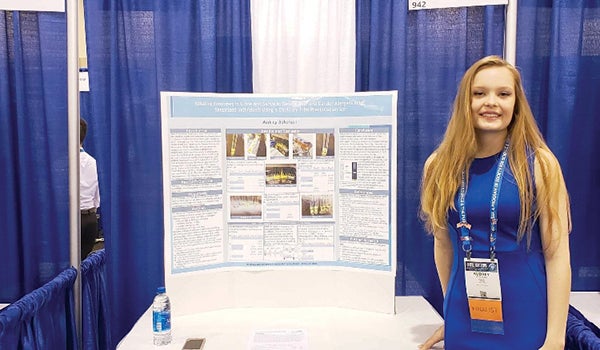SMC grad, Niles native hopes to impact millions with research
Published 8:38 am Tuesday, December 31, 2019
NILES — During her sophomore year of high school, Audrey Bakerson, of Niles, began a project meant to help people in developing nations. She researched ways to create solar-powered refrigeration, so preserving medication and food would not need a generator or an electric grid.
Now, as a high school senior, a recent college graduate and an upcoming laboratory employee, the homeschooled student is about to start her fifth research project in the science field. Each is meant to lay the groundwork for products that could each ease the lives of millions.
SMC successes
Bakerson’s most recent advances in two projects were presented to the public Dec. 5 at the fourth annual Honors Program Showcase at Southwestern Michigan College’s Dale A. Lyons Building, 58900 Cherry Grove Road, Dowagiac.
The two projects were presented on poster board and discussed by Bakerson to attendees. One was on her work to mutate rye grass to absorb heavy metal pollutants in water. The other was on trends of Eastern Equine Encephalitis virus, a potentially deadly disease carried by mosquitoes that saw a serve uptick in cases in southwest Michigan.
Bakerson’s presentation of metal pollutant removal was a culmination of four semesters of work at SMC on the subject.
In semesters past, she worked to find and mutate plants to create a “super plant,” she said, one that could effectively absorb metals, such as lead, from water.
This semester, she chose her plant, rye grass, and put it to the test.
“This [school] year, I was seeing, quantitatively, how the lead can actually absorb,” Bakerson said. “I put in 300 parts per million of lead and was getting out that the plants were taking out 250 parts per million, which was pretty good.”
Using plants to effectively suck out pollutants could make water systems safer to drink from, fish from and swim in.
Bakerson chose rye grass because it grew quickly, was easy to find at stores and cost little. This was especially ideal, she said, during the beginning phases of the project, where many plants died.
Other cheap, accessible plants, however, turned out to be better suited for metal absorption. Her friend and research peer, Anaya Roschyk, also completed a similar project, using cilantro instead.
Cilantro absorbed much better than rye grass when their volumes and masses were compared, Bakerson said.
Next year, she will compare her work with Roschyk, then attempt to mutate the rye grass to maximize its bio-absorption.
While Bakerson’s grass project has been ongoing for many months, her second honors program project on EEE came about recently from an issue both local and personal.
A family friend of the Bakerson family caught the Triple E virus this year, suffering brain damage as a result. The friend was one of 35 known cases of the virus infecting people in Michigan, a jump between five and 10 cases in the past six years and a jump from 15 cases in 2012, the previous record high.
“I was looking into correlations between the last two highest years, 2010 and 2012, and kind of comparing what was the change temperatures-wise, precipitation-wise,” Bakerson said.
While 2010 and 2012 were high-temperature, low-precipitation years, 2019 was a low-temperature, high-precipitation year.
Bakerson said this finding showed that a wet year could lead to an increase of EEE cases.
To test this theory, Bakerson said she would like study future years, which she predicts could have high rates of Triple E virus infection rates.
Unfortunately, Bakerson graduated from SMC in May, so she does not have the time to study for years in the future — she is already completing college research with a degree.
Instead, Bakerson said she plans to continue compiling information she thinks may correlate to EEE case surges from years past.
Future projects
The reason why Bakerson is not planning to continue her SMC research years into the future is two-fold. First, she plans to head to a four-year university next fall. Second, she plans on continuing three other research projects once there.
One of those projects involves EEE, and Bakerson hopes to use her SMC statistical research on the virus to allow her work in the laboratory with it.
While plans are still in their infancy, Bakerson hopes to work with other researchers to create a product that will prevent mosquitoes carrying EEE from successfully breeding.
“It has huge implications, because we can bring it out in third-world countries, where they have other mosquito-born viruses,” she said.
Bakerson’s other project she hopes to continue into the future is one she has worked on for three years, primarily through Andrews University and the Berrien County mathematics and Science Center.
First, she hopes to test for allergies by taking saliva and urine samples. If someone is found to be allergic to something, she will then isolate and coat a part of the sample, called exosomes, with an antibody, rendering the sample non-reactionary to an allergy-inducing object.
Finally, Bakerson would inject the coated exosomes into the patient, curing them of their allergies.
The process would provide a cure without injecting the allergen back into the body, a process that, on rare occasion, can induce anaphylactic shock in some patients whose immune systems are extremely weakened, she said.
While Bakerson is currently on break from school and from work, come January, she will begin working in a laboratory, undergoing her fifth concurrent research project.
Bakerson hopes her high school, collegiate and work-related opportunities now pay big dividends in the near future. She hopes it will allow her to pursue projects with professors usually reserved for upperclassmen or graduate students.
“Hopefully I won’t have to go in cleaning dishes,” she said.
Instead, she may be working with petri dishes, analyzing and quantifying the next big cure.







